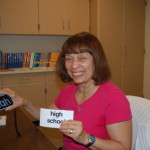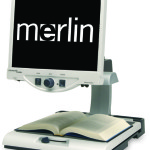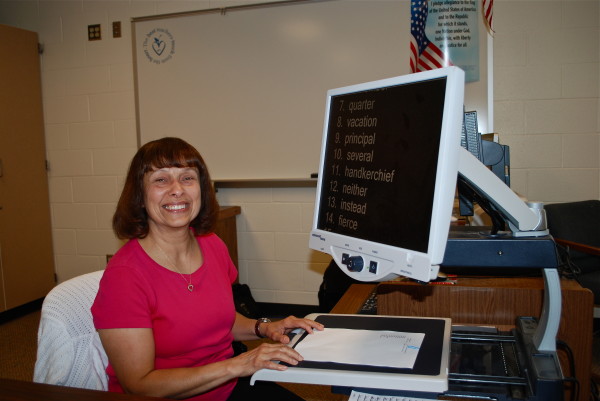Shari Petersime has been a junior/high school life skills teacher for kids with special needs for many years. She has been teaching for a total of 38 years and currently teaches the life skills class at North Eastern Wayne High School in Fountain City, IN. She teaches the kids in this class how to cook, grocery shop, and sew in addition to teaching their core classes such as english and math. The students also have an opportunity to obtain hands on job experience by working at Meijer for a semester.
I met with Shari in her classroom at North Eastern Wayne High School. She is a warm and friendly person who loves teaching. Shari has a visual impairment and I met with her to learn what types of  assistive technology she uses to assist her in her teaching duties. Shari shared with me that when she was 10 years old she was diagnosed with what she thought was night blindness. When she got married at the age of 26 her parents told her husband that she actually had been diagnosed with Retinitis Pigmentosa (RP). That is the first time she learned about her diagnosis. RP is an inherited condition that is an eye disease that causes damage to the retina. The retina is tissue at the back of the inner eye that converts light images to nerve signals and then sends them to the brain. Symptoms often appear in childhood and typically become more severe in early adulthood. Symptoms may be: decreased vision at night or in low light, loss of peripheral (side) vision which causes tunnel vision, and in advanced cases there is loss of the central vision.
assistive technology she uses to assist her in her teaching duties. Shari shared with me that when she was 10 years old she was diagnosed with what she thought was night blindness. When she got married at the age of 26 her parents told her husband that she actually had been diagnosed with Retinitis Pigmentosa (RP). That is the first time she learned about her diagnosis. RP is an inherited condition that is an eye disease that causes damage to the retina. The retina is tissue at the back of the inner eye that converts light images to nerve signals and then sends them to the brain. Symptoms often appear in childhood and typically become more severe in early adulthood. Symptoms may be: decreased vision at night or in low light, loss of peripheral (side) vision which causes tunnel vision, and in advanced cases there is loss of the central vision.
Shari shared with me that this degenerative disability did not start really affecting her until about ten years into her teaching career. She started having trouble navigating around the school because there was no contrast of color in the school building. She also began to need magnification to read normal 
 sized print and also to write. Shari now uses a Merlin CCTV, Candy Portable Video Magnifier and Zoom Text software to read and write. The CCTV’s magnify the print on documents. The ZoomText software magnifies text on a computer screen. You can also change the contrast of the computer screen and use speech output options with ZoomText. In the classroom, she uses the CCTV’s to create school assignments and read and she uses the voice output system on Zoom Text to read her e-mails aloud to her.
sized print and also to write. Shari now uses a Merlin CCTV, Candy Portable Video Magnifier and Zoom Text software to read and write. The CCTV’s magnify the print on documents. The ZoomText software magnifies text on a computer screen. You can also change the contrast of the computer screen and use speech output options with ZoomText. In the classroom, she uses the CCTV’s to create school assignments and read and she uses the voice output system on Zoom Text to read her e-mails aloud to her.
Shari began to work with Easter Seals Crossroads Rehabilitation Center (ESC) when she received information from her local independent living center that she may qualify for a grant to receive a free iPad and iPad training. This grant is federally funded grant administered by the Indiana Family and Social Services Administration, Division of Disability and Rehabilitative Services. The state passes the grant funds to ESC to execute the grant program. Through this program visually impaired individuals who are 55 years old or older who reside in specific counties in Indiana can receive a free iPad. The goal of this grant is to provide assistive technology services/equipment to elderly visually  impaired individuals who live in under/unserved counties.
impaired individuals who live in under/unserved counties.
Interested individuals will receive an iPad and training if they meet the following criteria:
- Age 55 or over as of the date of mandatory initial training
- For the grant period between now and September 30, 2013, applicants have to be residents of 24 counties in most of Central Indiana: Adams, Blackford, Boone, Carroll, Clinton, Delaware, Fountain, Grant, Hamilton, Hancock, Henry, Howard, Jay, Madison, Montgomery, Parke, Putnam, Randolph, Tippercanoe, Tipton, Vermillion, Warren, Wayne and Wells
- For the grant period between October 1, 2013 and September 30, 2015, applicants have to be residents of any county in Indiana
- Have identification to prove age and county residency
- Visually impaired and can provide a doctor’s statement for support
- Have own means of transportation to a public meeting place with free WiFi internet access
- Have contact of a family member or friend who is familiar with iPad or similar technology
Shari is currently getting ready for a new chapter in her life. In a few weeks, Shari will be retiring. She is very excited for retirement and looks forward to start traveling more often. She loves to travel to historic sites and is thrilled to have the iPad to be able to use the voice over feature to book travel and learn more about the places she visits. Her favorite thing about the iPad has been the use of the camera. She can use this to take pictures of things she wants to see and can then zoom the picture to be able to see the details.
Something that Shari hopes to become more involved in is increasing awareness of accessible travel. She got interested in this when she wanted to visit the Lincoln Cottage in Washington D.C.. It was the anniversary of the reading of the gettysburg address which would be read out loud by visitors. She called to see if Lincoln Cottage was doing anything interactive. The lady she spoke with came up with the idea to call her on a cell phone to allow her to participate. After this they discussed ways that the cottage tour could become more accessible. She hopes to get out to Washington D.C to meet with the staff and brainstorm other ways in which to improve accessibility.
Shari is thrilled about all the technology that has increased her independence. She is excited to learn more about her iPad when she has the time once she has retired. Shari also shared with me that she never wanted to use a white cane because she was concerned that it could make her vulnerable for people to take advantage of her. She indicated that at times this has caused her problems when she wants to ask for help. She indicated that without a visible sign of her disability she felt anxious if she needed to ask for help. At times when traveling with her husband she would need to ask for assistance into the women’s public bathroom since he was unable to assist her. She decided to start wearing a low vision button. She said this made things easier because she did not have to explain her need for assistance and she became less self-conscious in those situations. Learning simple tricks like this can often improve someones confidence and make it easier to ask for help. She knows with her button, iPad and more time she will be able to make traveling easier and more enjoyable.
Here is a video of Shari discussing her experience in getting an iPad and her suggestions for anyone who may benefit from assistive technology:
It was such a pleasure to meet Shari and learn about how she has been able to touch the lives of students and provide necessary life skills training with the use of assistive technology. We wish Shari a wonderful transition into the world of retirement and wish her all the best in her use of assistive technology to travel, explore, and learn more about history.
For additional information about the iPad project or to find out if you qualify, please contact the project coordinator Anna Leung, at 317-466-2001 ext. 2483 or aleung@eastersealscrossroads.org for any questions.


